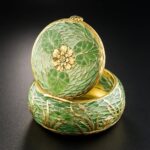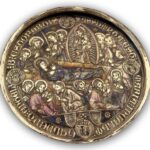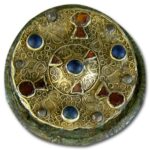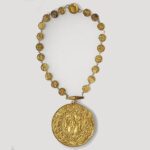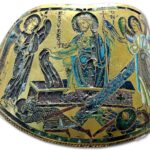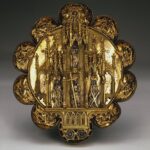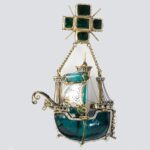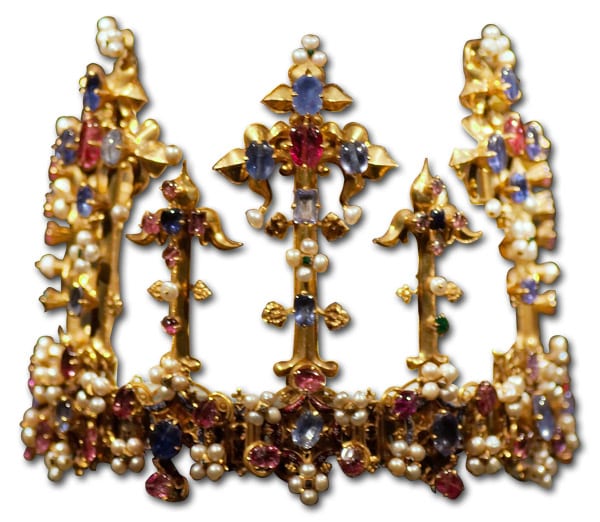
The ‘Middle Ages’ is a term that has been used to classify the period of European history which starts after the crumbling of the (Western) Roman Empire and ends at the start of the Renaissance. As with every attempt to chop history up into nicely defined blocks, there are pros and cons to this periodization. To avoid unclear situations we will take the time span 500 – 1500 AD as our Middle Ages and discuss only the European world and its direct neighbours in this period. Contemporary cultures such as South American jewelry, Asian jewelry, and African jewelry cultures and their jewelry will be dealt with separately.
The Dark Ages?
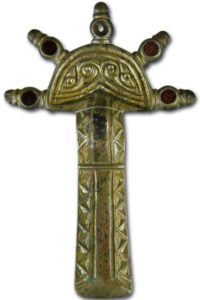
In more than one place one can read about the Middle Ages being the ‘Dark Ages’, a time where intellectual progress stagnated, and even regressed. Knowledge became the possession of the church and anybody disagreeing with the Catholic dogma was prosecuted. Artwork took a fall compared to the antique world of the Romans and Greeks. But, is this the whole truth? Were the Middle Ages a completely uninteresting period in which no innovations took place and no beautiful jewelry was produced? The answer to that question is a firm ‘no!’.
The term ‘Middle Ages’ is derived from Renaissance writers glorifying the Greeks and Romans for their intellectual achievements and artwork. To them, the period that lay between their own time and that of the Romans was an intermediate period. A period in which knowledge lay dormant, technical innovations were of marginal importance and people lived under the yoke of the church. Today, looking back on history without having to distance ourselves from any ‘Dark Ages’ we can see a whole different era. A period in which innovations were made, a time in which supreme craftsmanship was executed and mind-blowing jewelry continued to be produced.
Early Middle Ages
The end of the antique world has been marked by the crumbling of the Western Roman empire. The first centuries of the Empire (0 – 300 AD) had seen relative peace and prosperity but the Roman emperors had two major problems. The first was that of the succession of the Emperor himself and the second was the size and mobility of the army (some 300.000 men strong). Every time an emperor died his succession was subject to political and even military intrigue and the army wasn’t large and mobile enough to provide an effective defense along the long borders of the empire. Around 400 AD large numbers of Germanic tribes entered the empire while another number of tribes were allowed access to the empire under the pretension that they would help defend the borders. This triggered the period we call the Migration Period, a time in which whole populations moved from east to west and from north to south. A lot of these tribes had been living near, or right next to the Roman Empire and had known a long tradition of interaction with the tribes living within the Roman borders and with Romans themselves. History often describes these people as barbarians but let’s have a look at their jewelry.
Germanic Tribes
The Germanic cultures that crossed the rivers Danube and Rhine into the Roman Empire in the 5th century and caused the fall of the empire as it had existed for nearly 500 years had strong similarities in their technical abilities and decorative tastes. Their goldsmiths were familiar with Roman techniques and the jewelry they produced was of remarkable quality. Germanic burial rituals included sending their deceased off to the afterlife in full ornate dress which has caused us to have a good understanding of what jewelry was worn and by whom. Great technical complexity, fine materials, and bold designs are keywords when we are speaking about ‘barbaric jewelry’. Over time the Germanic tribes settled down, and converted to Christianity and their jewelry became subject to Byzantine influences.

Byzantine Empire

It was the Roman emperor Diocletian (who reigned from 284 to 305) and split up the empire into two parts, an Eastern and Western Empire, in an attempt to tackle the problems that came with governing such a vast empire. His successor, Constantin I unified the empire again but did relocate the capital of the Empire to the old Greek city of Byzantium. Another important act of Constantin was adopting Christianity as his religion at the end of his life thus straightening the path for Christianity to become the main religion in Europe. The capital, now called Constantinople, proved to be a safe haven for Roman rulers right up until the 15th century. It goes without saying that a continuation of Roman jewelry manufacture took place in the new Byzantine Empire. The adoption of Christianity provided new motifs and the wealth of the city is reflected in its jewelry.
Islamic Jewelry
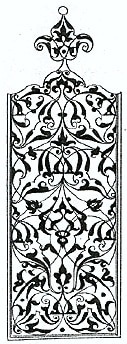
Around 570 AD the prophet Muhammad was born in Mecca. After receiving ‘messages’, later to be thought of as coming from the angel Gabriel, he started preaching new ideas and developed a large number of followers. By the end of his life, the larger part of the Arabic peninsula was unified under an Islamic state. In the hundred years after Mohammed’s death in 632, the Islamic world expanded its territories rapidly. By 732 it stretched from the Iberian peninsula to the Indus valley in India. Islamic burials didn’t include any artifacts to be buried with the dead and most jewelry has subsequently been lost; it was recycled. Any jewelry that did survive is hard to date because there are no distinct changes to be observed in form, decoration, and techniques. The goldsmiths of the Early Islamic world continued to work in the Roman/Byzantine and Sassanian styles. It is only from the 11th century on that a distinctly Islamic style can be observed. Arabic inscriptions on jewelry and a strong use of granulation and openwork filigree became fashionable. Cairo is named as an important production center for Arabic jewelry which has been found throughout the Islamic world.
Romanesque Jewelry
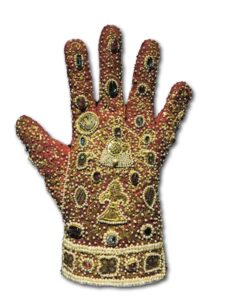
Imperial Glove in Schatzkammer in Wien (Austria).
After the Germanic tribes of Europe settled down, the Great Migration period and the chaos it had caused came to an end. Clans eventually united themselves under kings, when there was a need for it, and it was Charlemagne who was the first to unite a large part of Europe under an Empire in 800 AD. His Empire grew out to be the Holy Roman Empire in which a certain stability was maintained. This allowed progress to be made in the world of art. The new court was influenced by Byzantine fashion, an influence that proved to last under his successors, the Ottonian Emperors.
Christian iconography flourished in jewelry and was spread further through monasteries that were founded throughout Europe. It is these monasteries that acted as a hub for the art of goldsmithing. Here the techniques were initially taught to secular jewelers who inhabited the newly founded cities of the 10th and 11th centuries. France and England were torn by feudal wars and Norman invasions until the turn of the millennium which tempered progress in these areas over the Early Romanesque period. But, by the 11th century cities provided safe havens for craftsmen to settle and do their jobs everywhere in Europe. This marked the beginning of the self-employed, secular jeweler-goldsmith as we know him now.
High Middle Ages
Gothic Jewelry
After the fourth crusade got no further than the plundering of Constantinople in 1204 AD, the Byzantine Empire’s powers dwindled. With the demise of the empire, its influence on the rest of Europe diminished and eventually, the Byzantine fashion fell from favour. Certain types of jewelry such as earrings and bracelets disappeared from the bodies of European ladies. A new style emerged following the developments in architecture that had started in the 1140s. A gradual change from Romanesque styles to Gothic ones took place. This was reflected in jewelry designs by the late 13th century. Pointed rather than rounded forms were used and the heavy, dense surface decoration that had been a remnant from the classical past were replaced by more simple and elegant designs. Enamel work became even more beautiful and was used more elaborately. A love for romance, resulting in the gifts of jewelry from lovers to one another, an increased supply of gemstones from the East, the rise of gem cutting and the solid establishment of the independent goldsmith/designer caused a new flow of jewelry to adorn the bodies of men and women.
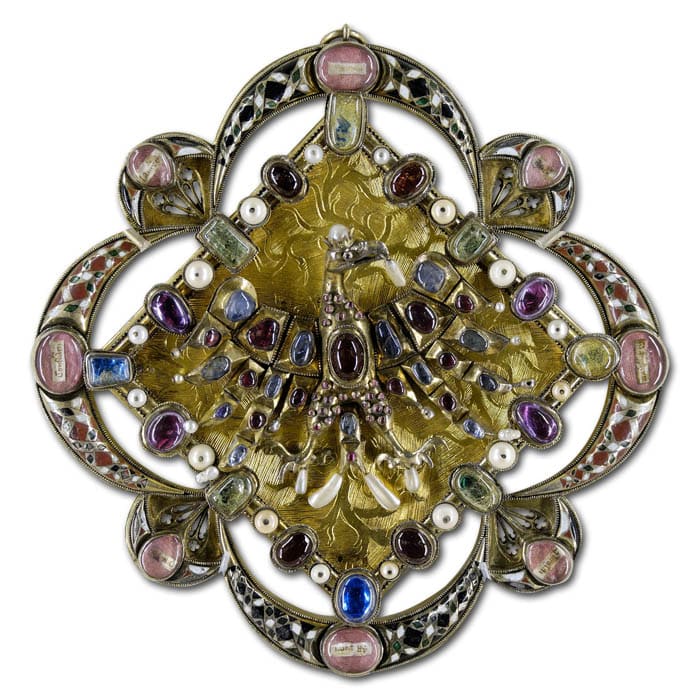
Late Middle Ages
Late Gothic to Early Renaissance
From 1375 AD on Gothic jewelry designs changed toward a more natural form. Clare Phillips describes it as a ‘softening of forms’.1 Gem cutting became an art in itself and designs became more complex although still elegant. During the 15th century early signs of a new movement, the Renaissance, stuck up their heads in Italy but the Gothic style persisted in Northern Europe and England until the 16th century.
From sublime Germanic inlay work to the complicated techniques of emaille en ronde bosse, the Middle Ages have been a time where vast progress took place on many fronts. The founding and uprise of cities provided safe havens for traders and craftsmen to do their jobs and specialize their skills. These conditions are a necessity for technological innovation. The organisation of goldsmiths in guilds stimulated education and collaboration of independent goldsmiths and sparked things like quality control. The increased trade with the East eventually led to the discovery of new continents. These are all very important aspects without which jewelry, as we know it today, wouldn’t exist.
Timeline
Middle Ages
General History
- Germanic Tribes Invade the Roman Empire, the Migration Period Starts.
General History
- Byzantine Emperor Justinian Takes up Laws Regulating the Wearing and Usage of Jewelry in a New Set of Laws, Later to be Called the Justinian Code.
Discoveries & Innovations
- The San Vitale Mosaic is Completed in Ravenna.
General History
- The prophet Muhammad is Born, by the End of his Life in 632 a Large Islamic State has Been Established.
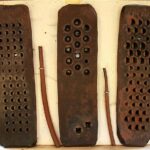
Discoveries & Innovations
- Earliest Evidence of Metal Drawplate Usage in the Western World.
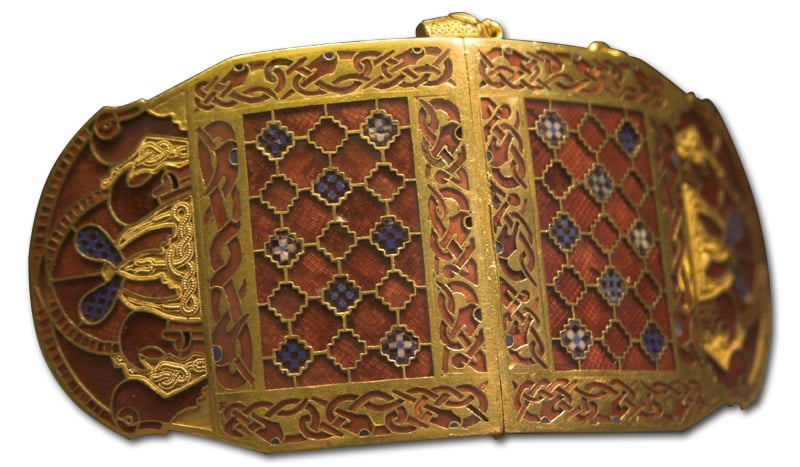
Jewelry History
- King Raedwald of East Anglia Receives a Burial at Sutton Hoo with Extraordinary Jewelry By his Side.
General History
- Charles the Great is Crowned Emperor. In Choosing a Court style Charles Picks the Romanesque Style after Byzantine Example.
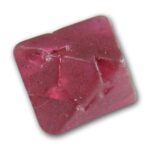
Discoveries & Innovations
- Mining of Red Spinel Begins in Badakshan, Afghanistan Between 750 and 950 AD
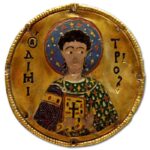
Jewelry History
- Cloisonné Enamel Finds its Way into the Workshops of Byzantine Goldsmiths.
General History
- The Crowning of Otto I Marks the Beginning of the Holy Roman Empire.
General History
- The First Crusade is Launched.
Discoveries & Innovations
- The Loot of the First Crusade Containing Incredible Amounts of Precious Stones and Gold is Transported From the Holy Land to Northern Europe.
Jewelry History
- A Distinct Arabic Style Emerges in Jewelry of the Islamic World.
Discoveries & Innovations
- Chinese Originate the Concept of Pearl Culturing (1100-1300?)
General History
- The Gothic Period in Art History Starts (Lasts Until the 16th Century)
Jewelry History
- The Goldsmiths of London Start a Guild.
Jewelry History
- Laws Regulating the Wearing of Jewelry are Instated in Aragon.

Jewelry History
- The Gothic Style Starts to Influence Jewelry.
- French Laws Regulating the Wearing of Jewelry are Instated (1283)
- First Record of The Horner’s Co., London.

Jewelry History
- Earliest evidence of diamond cutting (the point-cut) in Venice.

Jewelry History
- Charles the Bold, Duke of Burgundy is Born (dies 1477). He is Believed to Have Owned the Florentine Diamond.
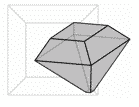
Jewelry History
- The Table Cut for Diamonds is Introduced. (c.)
General History
- Albrecht Dürer is Born (Dies 1528).
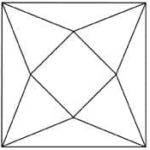
Jewelry History
- The First French Cut Diamonds are Cut During the 15th Century.
Jewelry History
- First Diamond Engagement Ring Given to Mary of Burgundy by Emperor Maximilian I.
Discoveries & Innovations
- Leonardo da Vinci Designs a Rolling Mill.
Sources
- Middeleeuwen, de Boer, D.E.H, van Herwaarden, J and Scheurkogel, J. Martinus Nijhoff uitgevers, Groningen, The Netherlands, 1995.
- 7000 Years of Jewellery, Various Authors, edited by Hugh Tait, British Museum Press, London, 1986.
- Ancient Jewellery: Interpreting the Past, Ogden, Jack, British Museum Press, London, 1992.
- Jewelry, from Antiquity to the Present, Phillips, Clare, Thames & Hudson, London, 1996.
- A History of Jewellery 1100-1870, Evans, Joan, Dover Publications, Inc, New York, USA, 1953/1970.
